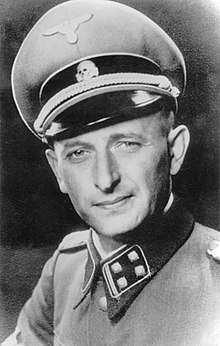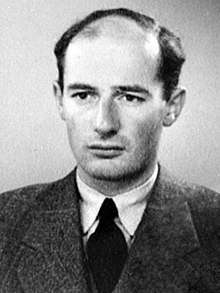The Holocaust in Hungary
The Holocaust in Hungary was the final act of mass murder of a Jewish community by Nazi Germany during the 1941–1945 genocide of the European Jews.[1] New restrictions against Jews were imposed soon after Germany occupied Hungary on 19 March 1944. The invading troops included a Sonderkommando led by SS officer Adolf Eichmann, who arrived in Budapest to supervise the deportation of the country's Jews to the Auschwitz concentration camp in occupied Poland. Between 15 May and 9 July 1944, over 434,000 Jews were deported on 147 trains,[2] most of them to Auschwitz, where about 80 percent were gassed on arrival.[3]
| The Holocaust in Hungary | |
|---|---|
_3a.jpg) Hungarian Jews arriving at Auschwitz II-Birkenau, German-occupied Poland, May/June 1944 | |
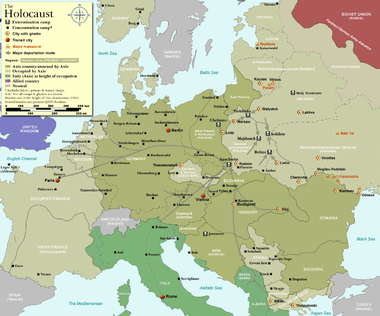 Europe in 1942 | |
| Location | Hungary |
| Date |
|
| Perpetrators | Nazi Germany, Adolf Eichmann, László Ferenczy, Arrow Cross Party |
| Camp | Auschwitz concentration camp |
| Ghetto | Budapest ghetto |
| Victims |
|
| Memorials | Shoes on the Danube Bank |
At the time of the German invasion, Hungary had a Jewish population of 825,000,[4] the largest remaining in Europe,[5] further swollen by Jews escaping from elsewhere to the relative safety of that country. The Hungarian Prime Minister Miklós Kállay had been reluctant to deport them.[6] Fearing Hungary was trying to pursue peace with the Allies, Adolf Hitler ordered the invasion.[7]
After the publication in June 1944 of parts of the Vrba-Wetzler report—a report compiled in April by two Auschwitz escapees that described in detail how Jews were being gassed in the camp—diplomatic pressure and the Allied bombing of Budapest persuaded Miklós Horthy, the Regent of Hungary, to order a halt to the deportations on 6 July.[8] By the time they had stopped three days later, almost the entire community of Jews in the Hungarian countryside had gone.[lower-alpha 1]
The killings have puzzled historians, particularly given that the gas chambers and crematoria at Auschwitz struggled to cope with the numbers, because they took place as World War II appeared to be drawing to a close. The Allies had begun the liberation of Europe—the Normandy landings were on 6 June 1944—and world leaders had known for some time that Jews were being murdered in gas chambers. As a result, the Holocaust in Hungary has triggered a long debate about why Germany pressed ahead with it and whether governments, journalists and community leaders should have done more to publicize and disrupt it.[10]
Jews in Hungary
In the 1941 census, the population of Hungary was 14,683,323. Of these, 725,005 regarded themselves as Jews (4.94 percent) and another 100,000 were "racial Jews" who identified as Christian. Over 400,000 lived in post-Trianon Hungary and another 324,000 lived in territories acquired by Hungary since 1938: Northern Transylvania from Romania (164,000), part of Upper Hungary from Czechoslovakia (146,000), Carpathian Ruthenia (78,000), and Bácska and other areas that had been part of Yugoslavia (14,000).[4]
| Budapest | Provinces | Total | Acquired territories | Total | Source | |
|---|---|---|---|---|---|---|
| Jews | 184,453 | 216,528 | 400,981 | 324,026 | 725,007 | [11] |
| Jewish Christians | 62,350 | 27,290 | 89,640 | 10,360 | 100,000 | [11] |
| Total | 246,803 | 243,818 | 490,621 | 334,386 | 825,007 | [11] |
German occupation
Invasion
On 18 March 1944, Adolf Hitler summoned Horthy to a conference in Austria, where he demanded greater acquiescence from Hungary. Horthy resisted, but his efforts were fruitless. While he was at the conference, German tanks rolled into Budapest, and on 23 March the government of Döme Sztójay was installed. Among his first moves, Sztójay legalized the Arrow Cross Party, which quickly began organizing. During the four days' interregnum following the German occupation, the Ministry of the Interior was placed in the hands of László Endre and László Baky, right-wing politicians known for their hostility to Jews. Their boss, Andor Jaross, was another committed antisemite.
Adolf Eichmann
SS-Obersturmbannführer Adolf Eichmann, sent to Hungary to supervise the deportations, set up his staff in the Majestic Hotel in Budapest. The Yellow Star and ghettoization laws, and the deportations, were accomplished in less than eight weeks, with the enthusiastic help of the Hungarian authorities, particularly the gendarmerie (csendőrség). The plan was to use 45 cattle cars per train, four trains a day, to deport 12,000 Jews from the countryside every day, starting in mid-May; this was to be followed by the deportation of Jews from Budapest from about 15 July. Rudolf Höss, the first commandant of Auschwitz, returned to the camp between 8 May and 29 July 1944 as the local SS garrison commander to oversee the Hungarian Jews' arrival and gassing.[12] As a result, the Germans called the murders Aktion Höss ("Operation Höss").[13]
Deportation to Auschwitz
First transports
The first train left Budapest on 29 April 1944 carrying 1,800 men and women aged 16–50 who were deemed fit to work. A second train left Topoly on 30 April carrying 2,000. The transports went through "selection"; 616 women (serial numbers 76385–76459 and 800000–80540) and 486 men (serial numbers 186645–187130) were chosen to work, and 2,698 were gassed.[14]
Mass transports
_1b.jpg)
The mass transports, the first organized by the Reichssicherheitshauptamt (Reich Security Head Office or RSHA),[15] began leaving Hungary for Poland on 14 May 1944. The Hungarian government was in charge of them up to the northern border. The commander of the Kassa railroad station kept a record of the trains. The first freight train passed through Kassa on 14 May. On a typical day, there were three or four, each carrying 3,000–4,000. There were 109 trains for 33 days until 16 June. On several days, there were six trains. From 25–29 June, there were 10, then 18 on 5–9 July. Another 10 trains were sent to Auschwitz via other routes.
The first three trains, each consisting of 40–50 cars, arrived at Auschwitz on 16 May. After unloading their belongings, the deportees were organized into rows of five, then led to the crematoria. According to Danuta Czech, it was from this night onward that smoke became visible from the crematoria chimneys.[15] The camp resistance referred to the deportations in a report covering 5–25 May 1944:
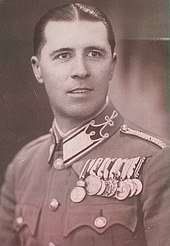
Auschwitz: Operation Höss. Since the middle of May numerous transports of Hungarian Jews. Every night eight trains arrive; every day five. The trains consist of 48 to 50 cars each, and in each car are 100 people. 'Settlers' arrive with these transports. Each train of 'settlers' also has two freight cars of lumber, which the 'settlers' unload on the 'death ramp', bring to another site and stack in piles ... that are intended for them. In order to simplify the work, the people arrive already separated, for example, children in separate cars. The closed trains wait for several hours on the special track to be unloaded. They stand in the nearby small forest.[16]
From 3 June, the electric fence was kept switched on during the day, instead of only at night (because there were guards during the day), because of attempts by Hungarian Jews to escape from the crematoria.[17] The camp resistance reported on 15 July that there had been a pause of several days in the transports after 13 June, and that between 16 May and 13 June, over 300,000 Jews from Hungary had arrived at the camp in 113 trains.[18] According to Höss during his trial, the facilities at Auschwitz could not cope with the numbers, and he had to travel to Budapest to reorganize the transports so that two or three trains would run on alternate days. Altogether, 111 trains were to be used. According to Höss, Heinrich Himmler, head of the SS, wanted the deportations to speed up.[15]
By 9 July 1944, 434,351 Jews in 147 trains had been deported, according to László Ferenczy of the Hungarian Royal Gendarmerie. According to Edmund Veesenmayer, the Reich plenipotentiary in Hungary, the figure was 437,402.[lower-alpha 2][lower-alpha 3] About 80 percent of deportees were gassed on arrival.[3] Because the crematoria were unable to cope with the number of corpses, pits were dug where bodies were burned. Photographs taken at Auschwitz (the Auschwitz Album) were found after the war showing the arrival of the Hungarian Jews at the camp.[21]
Selection
The 20 percent of new arrivals from Hungary selected as prisoners were used as slave labourers or in medical experiments. On 22 May and again on 29 May 2000 were selected for admission.[22] On 28 May, 963 were transferred from Auschwitz I to the Mauthausen concentration camp in Austria;[23] and on 5 June 2000 were sent to the Buchenwald concentration camp in Germany. The following day, Hungarian inmates with A-series serial numbers were transferred to Auschwitz III, a labour camp for IG Farben,[24] and another 2,000 were sent to Mauthausen that day and on 13 June.[25]
On 29 May, Miklós Nyiszli, a doctor who later worked for the camp's doctor, Josef Mengele, was admitted with his wife and daughter, although they were sent to different parts of the camp.[23] Any twins within the transports were selected; Mengele was notorious for his medical experiments on twins. On 17 May, any boys on the Hungarian transports born as a twin were admitted as prisoners (so-called "depot prisoners") and given serial numbers A-1419–A-1437. On 18 May, 20 females who were twin sisters were selected and given serial numbers A-3622–A-3641.[26] Twins were picked out repeatedly, including on 19, 20 and 21 May.[27]
Vrba–Wetzler report
Just before the deportations began, the Vrba–Wetzler report reached the Allies. The report provided a detailed description of the gas chambers and what was happening inside the camp; it had been dictated in April 1944 to the Slovakian Jewish Council by two Auschwitz escapees, Rudolf Vrba and Alfred Wetzler. Horthy's son and daughter-in-law both received copies of the report in early May, before mass deportations began.[28] Information from the report about the murder of Czech Jews in Auschwitz was broadcast in Germany by the BBC World Service on its women's programme at noon on 16 June 1944, with a warning that the Germans would be held responsible after the war.[lower-alpha 4] It was also published by the New York Times on 20 June.
The Western Allies landed in Normandy on 6 June 1944. On 15 June, the Mayor of Budapest designated 2,000 "starred" houses to which every Jew had to move; the idea was that the Allies would not bomb Budapest with starred houses scattered around the town. On the basis of the Vrba–Wetzler report, world leaders, including Pope Pius XII on 25 June, President Franklin D. Roosevelt on 26 June, and King Gustaf V of Sweden on 30 June, appealed to Horthy to stop the deportations. Roosevelt threatened military retaliation, and on 7 July Horthy ordered an end to them.[30]
Rescue efforts
Aid and Rescue Committee
Joel Brand
| Part of a series of articles on the Holocaust |
| Blood for goods |
|---|
|
Key figures |
|
Writers
|
|
Related
|
Joel Brand, a leading member of the Budapest Aid and Rescue Committee, became known for his efforts to negotiate with Eichmann to stop the deportations. In a meeting with Brand in Budapest on 25 April 1944, Eichmann offered to exchange one million Jews for 10,000 trucks from the Allies, to be used exclusively on the Eastern Front.[31] Eichmann called the proposal "blood for goods".[32] Using German travel documents, Brand travelled to Turkey to transmit the offer to the Jewish Agency, but the British government put an end to the talks by arresting Brand[33] and leaking details to the media.[34] On 20 July The Times called the proposal "one of the most loathsome" stories of the war and a "new level of fantasy and self-deception".[lower-alpha 5]
Rudolf Kastner
Another member of the Aid and Rescue Committee, Rudolf Kastner, was involved with Brand in negotiating the "blood for goods" deal with Eichmann and a separate—successful—deal with SS officer Kurt Becher to allow 1,685 Jews to leave Hungary for Switzerland in exchange for money and other goods. This became known as the Kastner train. After the war, Kastner testified in favour of Becher and other Nazis at the Nuremberg tribunal.[36]
Kastner later emigrated to Israel, where he became involved with Mapai and worked as a press officer for the Ministry of Commerce and Industry.[37] In 1954 he became the subject of a libel case brought by the Israeli government on his behalf against Malchiel Gruenwald, who alleged that Kastner had collaborated with the Nazis. It was the first big Holocaust trial in Israel.[38] Gruenwald had alleged in a self-published pamphlet that Kastner had known Jews were being gassed at Auschwitz as early as April 1944, after being given a copy of the Vrba–Wetzler report, but he had done nothing to warn the wider Jewish community in Hungary. Through his inaction, Gruenwald alleged, Kastner had helped the SS avoid the spread of panic, which would have slowed down the transports.[39]
In June 1955, the judge, Benjamin Halevi, decided in Gruenwald's favor, ruling that Kastner had "sold his soul to the devil".[40] Kastner and his associates had helped to persuade the Jewish community that they were being resettled, Halevi wrote in his 300-page judgment. In return, the SS had allowed the Kastner train to leave Hungary.[41] Israeli historian Tom Segev called the ruling "one of the most heartless in the history of Israel, perhaps the most heartless ever".[42] As a result of the verdict and its refusal to prosecute Kastner for collaboration, the Israeli government lost a vote of no confidence and collapsed.[43]
Kastner was assassinated in Tel Aviv in March 1957.[44] Most of the decision was reversed by the Israeli Supreme Court in January 1958. The majority opinion, written by Shimon Agranat, rejected the allegation of collaboration.[43] A dissenting opinion agreed with the original judgment that the ease with which the Nazis had murdered the Jews was "the direct result of the concealment of the horrifying truth from the victims".[45]
Raoul Wallenberg
Using his staff to prepare Protective Passports under the authority of the Swedish Legation, the Swedish diplomat Raoul Wallenberg saved tens of thousands of Jews in Hungary between July and December 1944. At one point, he appeared personally at the railway station in Budapest, insisting that Jews on the train be removed and presenting the Arrow Cross guards with Protective Passports for many of them. Budapest named Wallenberg as an honorary citizen in 2003; several sites honour him, including Raoul Wallenberg Memorial Park and the building that housed the Swedish Embassy in 1945. Yad Vashem recognized him as Righteous Among the Nations in November 1963.[46]
Arrow Cross rule
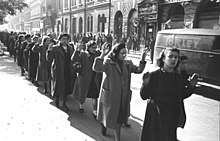
Horthy dismissed Prime Minister Sztójay on 29 August 1944, the same day the Slovak National Uprising against the Nazis began. After Prime Minister Ferenc Szálasi came to power in October, tens of thousands of Jews in Budapest were sent on foot to the Austrian border in death marches. Most forced laborers under Hungarian Army command were deported (for instance to the Bergen-Belsen concentration camp in Germany).
Two ghettos were set up in Budapest. The small "international ghetto" consisted of several "starred" houses under the protection of neutral powers in the Újlipótváros district. Switzerland was allowed to issue 7,800 Schutzpasses, Sweden 4,500, and the Vatican, Portugal and Spain 3,300 combined. The big Budapest ghetto walled in the Erzsébetváros part of Budapest on 29 November. Nyilas raids and mass executions occurred in both ghettos regularly. In addition, between November 1944 and February 1945, the Nyilas shot 10,000–15,000 Jews on the banks of the Danube. Soviet troops liberated the big Budapest ghetto on 18 January 1945. On the Buda side of the town, the encircled Nyilas continued their murders until the Soviets took Buda on 13 February.[47]
Hungarian gold train
The Hungarian gold train was a Nazi-operated train that carried stolen goods, mostly the property of Hungarian Jews, from Hungary to Berlin, Germany, in 1945. After seizure of the train by the Seventh United States Army, almost none of the valuables were returned to Hungary or their rightful owners or surviving family members.[48]
Number of survivors
Around 119,000 Jews were liberated in Budapest (25,000 in the small "international" ghetto, 69,000 in the big ghetto, and 25,000 hiding with false papers), as were 20,000 camp survivors and 5,000 forced labourers.[49] Randolph Braham estimated that just over 564,000 Hungarian Jews died between 1941 and 1945.[50] From over 800,000 Jews living within Hungary's borders in 1941–1944, about 255,500 are thought to have survived.[49]
See also
Notes
- Randolph Braham (2011): "[F]rom May 15 through July 9 [1944], close to 440,000 of the Jews of Hungary were deported to Auschwitz–Birkenau, where most of them were murdered soon after their arrival. By July 9, when Horthy's decision to halt the deportations took effect and Raoul Wallenberg arrived on his rescue mission, all of Hungary (with the notable exception of Budapest) had become judenrein."[9]
- "By July 9, when Horthy's July order halting the deportations was finally heeded, Ferenczy could report the deportation of 434,351 Jews in 147 trains. Ferenczy's figures were slightly lower than the 437,402 reported by Veesenmayer to the German Foreign Office."[19]
- Veesenmayer's telegram to Wilhelmstrasse (German Foreign Ministry) on July 11: "The concentration and transportation of the Jews from Zone V and the Budapest suburbs was concluded with 55,741 Jews on July 9, as planned. The total result from Zones I-V and the Budapest suburbs has been 437,402."[20]
- "News has reached London that the German authorities in Czechoslovak [sic] have ordered the massacre of 3,000 Czechoslovak Jews in gas chambers at Birkenau on or about June 20th. ... 4,000 Czechoslovak Jews who were taken from Theresienstadt to Birkenau in September 1943 were massacred in the gas chambers on March 7th.The German authorities in Czechoslovakia and their subordinates should know that full information is received in London about the massacres in Birkenau. All those responsible for such massacres from top downwards will be called to account."[29]
- The Times (20 July 1944): "It has long been clear that, faced with the certainty of defeat, the German authorities would intensify all their efforts to blackmail, deceive and split the allies. In their latest effort, made known in London yesterday, they have reached a new level of fantasy and self-deception. They have put forward, or sponsored, an offer to exchange the remaining Hungarian Jews for munitions of war—which, they said, would not be used on the Western front."The whole story is one of the most loathsome of the war. It begins with a process of deliberate extirpation and ends, to date, with attempted blackmail. ... The British Government know what value to set on any German or German-sponsored offer ... they know, as well as the Germans, what happens when one begins paying blackmail. The blackmailer increases his price. Such considerations provided their own answer to the proposed bargain."[35]
References
- Braham, Randolph L. (1998). "The Holocaust in Hungary: A Retrospective Analysis". In Braham, Randolph L.; Miller, Scott (eds.). The Nazis' Last Victims: The Holocaust in Hungary. Detroit: Wayne State University Press. pp. 27–43. ISBN 0-8143-2737-0.CS1 maint: ref=harv (link)
- Braham, Randolph L. (2016a). The Politics of Genocide: The Holocaust in Hungary. 1. New York: Columbia University Press. pp. 771, 774–775. ISBN 978-0880337113.CS1 maint: ref=harv (link)
- Kadar, Gabor; Vagi, Zoltan (2004). Self-financing Genocide: The Gold Train, the Becher Case and the Wealth of Hungarian Jews. Budapest and New York: Central European University Press. p. 125. ISBN 963-9241-53-9.CS1 maint: ref=harv (link)
- Braham 2016a, p. 88.
- Bauer, Yehuda (2002). Rethinking the Holocaust. New Haven and London: Yale University Press. p. 224. ISBN 0-300-09300-4.CS1 maint: ref=harv (link)
- Braham 2016a, pp. 429–430.
- Braham 2016a, p. 434.
- Braham 2016b, pp. 960–961, 967.
- Braham, Randolph L. (2011). "Hungary: The Controversial Chapter of the Holocaust". In Braham, Randolph L.; Vanden Heuvel, William (eds.). The Auschwitz Reports and the Holocaust in Hungary. New York: Columbia University Press. p. 45 (29–49). ISBN 978-0880336888.
- Braham 2016a, pp. xxxiv–xliii Also see Braham, Randolph L. (2016b). The Politics of Genocide: The Holocaust in Hungary. 2. New York: Columbia University Press. pp. 938–990. ISBN 978-0880337113.CS1 maint: ref=harv (link)
- Braham 2016a, p. 88, citing Hungarian Jewry Before and After the Persecutions. Budapest: Hungarian Section of the World Jewish Congress, 1949, p. 2.
- Lasik, Aleksander (2000). "Organizational Structure of Auschwitz Concentration Camp". In Długoborski, Wacław; Piper, Franciszek (eds.). Auschwitz, 1940–1945. Central Issues in the History of the Camp. I: The Establishment and Organization of the Camp. Oświęcim: Auschwitz-Birkenau State Museum. p. 154 (pp. 145–279). ISBN 978-8385047872. OCLC 874340863.CS1 maint: ref=harv (link)
- Lasik, Aleksander (1998) [1994]. "Rudolf Höss: Manager of Crime". In Gutman, Yisrael; Berenbaum, Michael (eds.). Anatomy of the Auschwitz Death Camp. Bloomington, IN: Indiana University Press. p. 295 (pp. 288–300). ISBN 0-253-20884-X.
- Czech, Danuta (1990). Auschwitz Chronicle 1939–1945. New York: Henry Holt and Company. p. 618. ISBN 0-8050-0938-8.CS1 maint: ref=harv (link)
- Czech 1990, p. 627.
- Czech 1990, pp. 633–634.
- Czech 1990, p. 640.
- Czech 1990, p. 666.
- Braham 2016a, pp. 774–775.
- Kadar & Vagi 2004, p. xxvi.
- "The Auschwitz Album". Yad Vashem. Archived from the original on 18 March 2013.
- Czech 1990, pp. 630, 636.
- Czech 1990, p. 636.
- Czech 1990, p. 641.
- Czech 1990, pp. 642–643.
- Czech 1990, p. 628.
- Czech 1990, pp. 628–630, 640ff.
- Bauer 2002, p. 157.
- Fleming, Michael (2014). Auschwitz, the Allies and Censorship of the Holocaust. Cambridge: Cambridge University Press. pp. 215, 366, note 190, citing the BBC Written Archives Centre (BBC WAC), C165, 16 June 1944. ISBN 978-1-107-06279-5.CS1 maint: ref=harv (link)
- Szita, Szabolcs (2005). Trading in Lives? Operations of the Jewish Relief and Rescue Committee in Budapest, 1944–1945. Budapest and New York: Central European University Press. pp. 50–54. ISBN 963-7326-30-8.CS1 maint: ref=harv (link)
- Braham 2016b, p. 1254ff.
- Fischel, Jack R. (2010). Historical Dictionary of the Holocaust. Lanham: Scarecrow Press. p. 31. ISBN 978-0-8108-6774-1.
- Braham 2016b, pp. 1259–1261.
- Fleming 2014, p. 236.
- "A Monstrous 'Offer'". The Times. Issue 49913, 20 July 1944, p. 2.
- Löb, Ladislaus (2008). Dealing with Satan. Rezsõ Kasztner's Daring Rescue Mission. New York: Jonathan Cape, pp. 274–277. ISBN 978-0-224-07792-7
- Segev, Tom (1993). The Seventh Million: The Israelis and the Holocaust. New York: Hill and Wang. p. 257. ISBN 978-0809085637.CS1 maint: ref=harv (link)
- Segev 1993, p. 255.
- Segev 1993, pp. 257–258.
- Braham 2016b, p. 975.
- Braham 2016b, p. 1290.
- Segev 1993, pp. 282–283.
- Braham 2016b, p. 1291.
- Segev 1993, p. 308.
- Braham 2016b, pp. 975, 1292.
- "A Swedish Rescuer in Budapest". Yad Vashem.
- Braham 2016b, p. 1505.
- "The Mystery of the Hungarian 'Gold Train'". Presidential Advisory Commission on Holocaust Assets in the United States. 7 October 1999. Archived from the original on 8 June 2011.
- Braham 2016b, p. 1507.
- Braham 2016b, p. 1509.
Further reading
- "Winston Churchill to Anthony Eden, 11 July 1944". Churchill Papers, Churchill Archives Centre, Cambridge.
- "German Troops Occupy Hungary". United States Holocaust Memorial Museum.
- "Deportation of Hungarian Jews". United States Holocaust Memorial Museum.
- Herczl, Moshe Y. (1993). Christianity and the Holocaust of Hungarian Jewry. New York: NYU Press. JSTOR j.ctt9qg6vj
- Vági, Zoltán; Csősz, László; Kádár; Gábor (2013). The Holocaust in Hungary: Evolution of a Genocide. Lanham: AltaMira Press. ISBN 978-0-7591-2198-0
